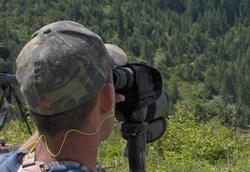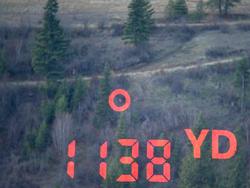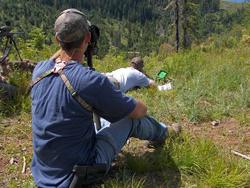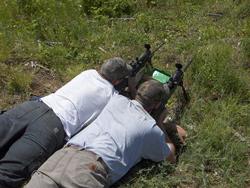Advantages Of Using The Long Range Spotter
By Shawn Carlock
Some people like hunting alone for a multitude of reasons, peace and quiet, to become one with nature, etc, etc. Most hunters have at least one hunting partner with them when taking to the field to go hunting. The world of long range hunting is no different except that when an animal is located to attempt a shot on one becomes the shooter and the other becomes the spotter. Let me make it perfectly clear that there is a huge difference between a hunting partner and a long range hunting spotter. While your spotter may also be your hunting partner, just because a hunting buddy can see through a spotting scope does not make him a long range hunting spotter. By definition a spotter is there to help the shooter spot and call the bullets impact and effect. There is a multitude of other things the spotter can do to make the buddy system work much better, let’s look at some the things the spotter can do.

Detecting game, two sets of eyes are better than one. This is pretty simple, but the spotter is also another opinion of things like trophy quality. The spotter can also stay eyes-on-the-target while the shooter sets up for the shot. Helping to dope the shot, a good spotter can really shine here while the shooter is setting up, the spotter can be keeping an eye on the target, laser the distance, work drop sheets or a PDA, take atmospheric condition readings, start to look at wind indicators and effects and possibly work the up/downhill angles. Often the spotter if he is squared away will get all of this done while the shooter is setting up for the shot.

If the spotter does this, all the shooter has to do is focus on the target and dial / hold where the spotter calls. This has the bonus effect of calming the shooter and inducing less stress from having to do everything themselves. Again if time allows the shooter and spotter should take a second to agree on the initial assessment of conditions especially the wind. The spotter’s number one duty when the shooter is in the final stage of releasing the shot is to watch for changing conditions that can affect the shot. These conditions are usually the wind or fog but could also be a predator or hot doe about to come in contact with the target and potentially effecting the targets position in the shot.

Spotting the shot, the spotter is now on the pay line. An educated and experienced spotter can usually spot a hit or miss by, reading trace, con trail, observing impact or animal reaction. This position allows for good spotting and protects from muzzle blast but shooter/spotter communication can be strained.
It is crucial that the spotter be pretty good at this as it is the basis for the flow chart of options to follow. If the spotter observes a miss he now needs to call a correction for the miss, a good spotter will do this in MOA, mils or what ever graduation the shooter is using to, make things easier for the shooter. The ability to call a miss in feet or inches accurately and quickly is a real plus. A good spotter will use clear easy corrections for the shooter. You will here this all too often:
Now let’s look at how that conversation goes with an experienced spotter and a MOA dialing shooter:

This position allows pretty good spotting position, fair muzzle blast protection and excellent communication, use of a spotting scope instead of a rifle would allow the spotter to slide back a foot or two and make this position excellent.
The spotter can also spot a less than perfect shot and make a correction in a timely enough fashion to put the poorly hit animal down. The best part is when the spotter gets to be the first to congratulate the shooter on a fine shot. The spotter can also save the shooter a hike by being able to call a solid miss where most shooters can not usually spot their own shots well enough to be certain of a miss. In my book that means a hike to be sure of the miss. I have spotted a number of missed animals that stopped in the brush to check out the disturbance after being startled, with a spotting scope. The shooter rarely picks these out.
Animal recovery, if the spotter sees the animal go down or just sees the last place it was before disappearing into the brush he can now direct the hunter into the location from the shooting location. Radios are handy where legal, and even handier a light weight hunter orange vest for both the spotter and hunter the wear to spot each other while the shooter is being guided in by the spotter. If low light is approaching tie a chem-light to your walker to be spotted easier by the spotter. Orange will fade with light just like any color but the chem-light can allow late evening recovery.
I am a big proponent of a 2 man system for long range hunting. Going solo is not impossible but teaming up makes things much more effective no mater how experienced you are. Take some time in the off season to practice with your spotter/hunting buddy and good luck this fall.
Shawn Carlock is a veteran law enforcement sniper and the current USPSA national precision rifle champion. He runs his business building custom rifles and conducting precision rifle training for civilian and law enforcement interests.
By Shawn Carlock
Some people like hunting alone for a multitude of reasons, peace and quiet, to become one with nature, etc, etc. Most hunters have at least one hunting partner with them when taking to the field to go hunting. The world of long range hunting is no different except that when an animal is located to attempt a shot on one becomes the shooter and the other becomes the spotter. Let me make it perfectly clear that there is a huge difference between a hunting partner and a long range hunting spotter. While your spotter may also be your hunting partner, just because a hunting buddy can see through a spotting scope does not make him a long range hunting spotter. By definition a spotter is there to help the shooter spot and call the bullets impact and effect. There is a multitude of other things the spotter can do to make the buddy system work much better, let’s look at some the things the spotter can do.

Detecting game, two sets of eyes are better than one. This is pretty simple, but the spotter is also another opinion of things like trophy quality. The spotter can also stay eyes-on-the-target while the shooter sets up for the shot. Helping to dope the shot, a good spotter can really shine here while the shooter is setting up, the spotter can be keeping an eye on the target, laser the distance, work drop sheets or a PDA, take atmospheric condition readings, start to look at wind indicators and effects and possibly work the up/downhill angles. Often the spotter if he is squared away will get all of this done while the shooter is setting up for the shot.

If the spotter does this, all the shooter has to do is focus on the target and dial / hold where the spotter calls. This has the bonus effect of calming the shooter and inducing less stress from having to do everything themselves. Again if time allows the shooter and spotter should take a second to agree on the initial assessment of conditions especially the wind. The spotter’s number one duty when the shooter is in the final stage of releasing the shot is to watch for changing conditions that can affect the shot. These conditions are usually the wind or fog but could also be a predator or hot doe about to come in contact with the target and potentially effecting the targets position in the shot.

Spotting the shot, the spotter is now on the pay line. An educated and experienced spotter can usually spot a hit or miss by, reading trace, con trail, observing impact or animal reaction. This position allows for good spotting and protects from muzzle blast but shooter/spotter communication can be strained.
It is crucial that the spotter be pretty good at this as it is the basis for the flow chart of options to follow. If the spotter observes a miss he now needs to call a correction for the miss, a good spotter will do this in MOA, mils or what ever graduation the shooter is using to, make things easier for the shooter. The ability to call a miss in feet or inches accurately and quickly is a real plus. A good spotter will use clear easy corrections for the shooter. You will here this all too often:
Holy crap you shot over him.
How far?
At least two feet.
At least two feet is that 2 feet or 3 feet?
Two feet.
Is that over his back or from my aiming point?
Where are you aiming?
Center chest behind the front shoulder.
2 Feet over his back.
So I need to hold 2 feet low?
No you need to hold 3 feet low.
How far?
At least two feet.
At least two feet is that 2 feet or 3 feet?
Two feet.
Is that over his back or from my aiming point?
Where are you aiming?
Center chest behind the front shoulder.
2 Feet over his back.
So I need to hold 2 feet low?
No you need to hold 3 feet low.
Now let’s look at how that conversation goes with an experienced spotter and a MOA dialing shooter:
“Correction, down 6.00 moa, windage good”
The spotter has done some quick math in his head prior to the shot 621 yards 1 moa = roughly 6 inches, every foot my shooter might be off would be just about 2 moa. On the shot and observing a 3 foot overshot the spotter quickly multiplies 3 times 2 moa and gives the shooter the 6 moa correction while he is reloading. This is the difference between a spotter and taking along a hunting buddy because he wasn’t doing anything that day.
This position allows pretty good spotting position, fair muzzle blast protection and excellent communication, use of a spotting scope instead of a rifle would allow the spotter to slide back a foot or two and make this position excellent.
The spotter can also spot a less than perfect shot and make a correction in a timely enough fashion to put the poorly hit animal down. The best part is when the spotter gets to be the first to congratulate the shooter on a fine shot. The spotter can also save the shooter a hike by being able to call a solid miss where most shooters can not usually spot their own shots well enough to be certain of a miss. In my book that means a hike to be sure of the miss. I have spotted a number of missed animals that stopped in the brush to check out the disturbance after being startled, with a spotting scope. The shooter rarely picks these out.
Animal recovery, if the spotter sees the animal go down or just sees the last place it was before disappearing into the brush he can now direct the hunter into the location from the shooting location. Radios are handy where legal, and even handier a light weight hunter orange vest for both the spotter and hunter the wear to spot each other while the shooter is being guided in by the spotter. If low light is approaching tie a chem-light to your walker to be spotted easier by the spotter. Orange will fade with light just like any color but the chem-light can allow late evening recovery.
I am a big proponent of a 2 man system for long range hunting. Going solo is not impossible but teaming up makes things much more effective no mater how experienced you are. Take some time in the off season to practice with your spotter/hunting buddy and good luck this fall.
Shawn Carlock is a veteran law enforcement sniper and the current USPSA national precision rifle champion. He runs his business building custom rifles and conducting precision rifle training for civilian and law enforcement interests.
*************************
Join the discussion of this article with the author at the [thread=23576]Article Discussion Forum[/thread]
Join the discussion of this article with the author at the [thread=23576]Article Discussion Forum[/thread]

